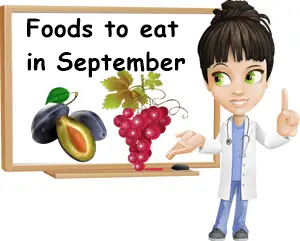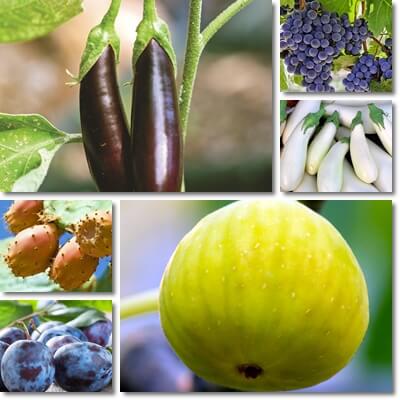What are some of the best foods to eat this September? September is a transition month with plenty of healthy and tasty choices food-wise. From late summer fruits and vegetables such as red and yellow watermelon, prickly pears or green tomatoes, to early fall goodies such as figs, grapes and plums, there’s quite a lot of deliciousness to be on the lookout for.
Whether these September foods are just now coming into season, or they’re approaching the end of their season, there are quite a few reasons to be eating them. Find out what are 9 of the best and healthiest seasonal September foods to eat right now.
1 Red and yellow watermelon
Even in September, watermelon is still going strong. If you’re going for pink and red fleshed watermelon, know you will be getting plenty of lycopene, a bright red pigment and antioxidant carotenoid with scientifically proven blood pressure lowering benefits. If you’re more adventurous, choose sweet yellow fleshed watermelon which is higher in xanthophylls, naturally occurring yellow carotenoid pigments and antioxidants that support the physical health of the eyes and provide benefits for visual acuity, color vision and vision in dim light, commonly called night vision.

2 Marrow (mature zucchini)
September is the time for marrow. What is marrow? Know the zucchinis you’ve been meaning to harvest for the past two weeks but always had something more urgent to do? Well, there’s your marrow. If you let your zucchinis grow on the vine past their immature summer squash size, they’ll be turning into squashes with a thick shell and lots of flesh. Extremely low in calories (under 20 kilocalories/100 g) and high in water, marrow makes a great fall food to help you lose weight in a healthy manner. You can get marrow from green, white, striped and golden zucchinis.
3 Eggplants
September is a great month to have eggplants. Choose from different sizes, shapes and colors such as dark purple, red purple, white, yellow or striped eggplants and get good nutrition all the same. Dark purple eggplants are highest in anthocyanin antioxidants with scientifically proven anticancer properties, but other colors are sources of important antioxidants too, namely manganese and chlorogenic acid. Just remember to cook your eggplants to reduce their allergenic potential.
4 Plums
Plums are one of the best September foods to look for in stores and at farmer’s markets. The more common dark purple plum varieties are high in anthocyanin antioxidants with scientifically proven anticancer effects, including free radical scavenging, anti-proliferative, enzyme-activating, anti-angiogenesis, apoptotic and anti-invasiveness effects (source).

5 Green tomatoes
Tomato season is not over. If you’ve had your fill of sweet ripe tomatoes, try green tomatoes for a change. Green tomatoes are an end of season fruit, or veggie, with several amazing benefits for health, including immune system enhancing effects and anticancer action against human lung, breast, colon, liver, stomach cancer cells and metastatic melanoma. See here the benefits of green tomatoes. You can also pickle your green tomatoes for a savory seasonal probiotic food to enjoy all winter.
6 Grapes
What is the first autumn seasonal food that comes to mind? Grapes, of course! Eat your grapes with skin to get a boost in antioxidants such as quercetin, kaempferol, myricetin, ellagic acid and many more and enjoy their free radical scavenging properties. Eating dark colored grapes helps combat cell damage buildup that is conducive to diseases and conditions such as atherosclerosis, diabetes, inflammation and cancer. Grapes are also a source of resveratrol, as are grape byproducts such as wine and must (fresh grape juice or ‘young wine’), and contribute to cardiovascular health via antioxidants and electrolytes such as potassium and magnesium.
7 Prickly pear (cactus fruit)
Despite being a summer fruit where they’re from, in Europe and many parts of the US prickly pears are just now hitting supermarket shelves. Prickly pear is the fruit to be eating this September. Studies show it has anti-diabetic properties, contributing to blood sugar control. While its many seeds make it cumbersome to eat, prickly pear is fragrant and sweet and has natural anti-inflammatory properties. You can even eat prickly pears if you have gastritis or an ulcer and not experience digestive upset. See more benefits of prickly pears.
8 Fresh figs
There isn’t a sweeter September fruit than figs. Freshly picked off the tree, figs deliver natural sugars to raise low blood sugar levels and combat side effects such as tiredness, fatigue, weakness and dizziness. Even though they are high in carbs and sugar (almost 20 g of carbs/100 g, 16 g of which are sugars), fresh figs have a low glycemic index score of only 35-40 meaning even diabetics can eat them in moderation. Dark-colored figs are highest in antioxidants, followed by red varieties and then yellow and green. Eat the figs whole, skin and flesh with seeds, for a boost in fiber and benefits for digestion.
9 Romanian Gogosari peppers
Romanian Gogosari peppers, also known as the Round of Hungary peppers, are the star of the season. All throughout Eastern Europe, farmer’s markets are flooded with with ribbed, fleshy, non-pungent, green and red peppers that are perfect for pickling either alone, marinated with dill, bay leaves, mustard seeds, sugar and vinegar, or together with white cauliflower or orange carrots, or used as stuffing peppers. Red Romanian Gogosari peppers are high in pro-vitamin A antioxidants such as beta-carotene, while green ones are high in chlorophyll. The peppers are also low in calories and a good source of vitamin C with anti-inflammatory action and benefits for gums and teeth.
